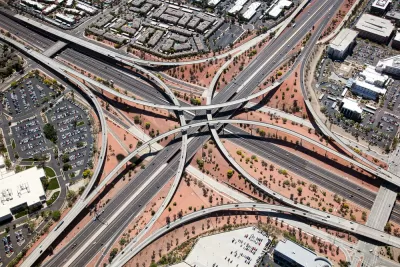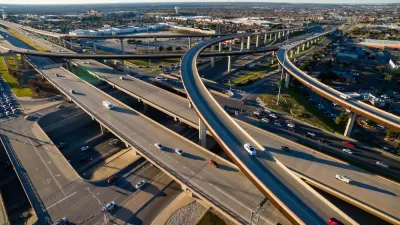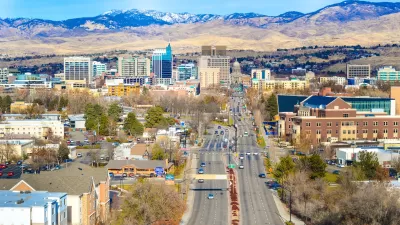Defenders of suburban expansion argue that government should build more roads in order to open up more land for housing. What's wrong with that argument?

The traditional libertarian-ish argument for suburban sprawl is that it is a product of the free market, and what the free market has created, no government may tear asunder. A wide variety of popular and scholarly commentary (including plenty of my own work) has criticized this view, by pointing out that government has encouraged automobile-dependent suburbia in a wide variety of ways.
As demand for urban housing has grown, the 1990s view that consumers prefer suburbs to urban cores has become implausible. But as housing costs have exploded, a new pro-sprawl argument has risen in its stead: the theory that government-supported suburbanization makes housing more affordable by opening up new land for development. For example, in his generally worthwhile recent book Order Without Design, Alain Bertaud writes that to "maintain a responsive supply of developed land, municipalities must therefore finance and build the expansion of primary infrastructure into a city’s periphery." In the U.S. context, such "primary infrastructure" usually means sprawl-generating highways.
This argument has a significant basis in fact: sprawling American cities do generally tend to be cheaper than compact ones (though there are exceptions in both directions: walkable Philadelphia is cheaper than sprawling San Diego). But it also seems to me that sprawl is not the best way to create more housing, for several reasons.
First, although sprawl is one way to create extra land, it is not the only way to do so. As Bertaud wisely notes, a city can "create" additional land by allowing more housing on urban land. For example, if a city allowed more multistory buildings instead of reserving huge chunks of cities for single-family houses, it would essentially be creating developable land in the air, thus increasing the supply of land. Similarly, if the city allowed smaller yards, it would increase the supply of land available for housing. This need not mean a city of 90-story skyscrapers; cities could allow incremental height increases instead, so that neighborhoods now reserved for one-or two-story houses could have four-story apartment buildings, and places with four-story apartment buildings could have eight-story buildings.
Second, sprawl creates transportation costs for drivers that at least partially offset the benefits of cheap real estate. For example, a typical household in Suffolk County, Long Island (the outer suburb where I work) spends over $14,000 on transportation, while a typical household in Manhattan spends just below $6,300 and a typical household in Queens spends just over $8,200 (more data here). It could be argued that the transportation cost gap between driving and active transportation is artificially inflated by public subsidies for public transit. But if policymakers use public transit subsidies as an excuse to support pro-sprawl policies, they are creating a self-fulfilling prophecy: pro-sprawl policies force transit to cover more territory to serve the same number of people, thus making transit more expensive and increasing per-capita transit subsidies. For example, New York's subway loses less than $1 per ride, while the rail systems of sprawling cities such as Santa Clara lose far more.
Third, sprawl development creates a variety of externalities that are typically not reflected in housing costs. The growth of automobile-dependent suburbs leads to increased vehicle use, which leads to increased greenhouse gas emissions and other pollution of all sorts, as well as increased likelihood of death and injury from automobile crashes.
In theory, it is possible that these externalities could be taxed and regulated away. For example, a state could calculate the social cost of automobile-related pollution, and impose a tax or fee sufficient to equal that cost. But sprawl actually makes it less likely that this could occur; when most people spend their lives inside their automobiles, they are likely to resist any attempts to tax auto use, and increased taxation of cars becomes politically radioactive.
It could also be argued that the rise of electric cars or some other technology will wipe out the environmental impacts of cars. This argument lacks merit, because in recent years American automakers and consumers have chosen gas-guzzling, dangerous sport utility vehicles rather than energy-efficient vehicles. As a result, American vehicles are not as energy-efficient as some of their European counterparts. Moreover, a single-minded focus on miles per gallon overlooks the other externalities caused by sprawl, such as increased injuries and death from speeding vehicles.
In sum, a government that aggressively promotes sprawl development might increase the supply of housing. But there are more environmentally friendly ways of achieving the same result.

Manufactured Crisis: Losing the Nation’s Largest Source of Unsubsidized Affordable Housing
Manufactured housing communities have long been an affordable housing option for millions of people living in the U.S., but that affordability is disappearing rapidly. How did we get here?

Americans May Be Stuck — But Why?
Americans are moving a lot less than they once did, and that is a problem. While Yoni Applebaum, in his highly-publicized article Stuck, gets the reasons badly wrong, it's still important to ask: why are we moving so much less than before?

Research Shows More Roads = More Driving
A national study shows, once again, that increasing road supply induces additional vehicle travel, particularly over the long run.

Toyota’s Hybrid Popularity Outpaces Production Worldwide
Soaring global demand for Toyota's hybrid vehicles is straining the automaker’s supply chain, leading to widespread delays as component shortages and limited production capacity challenge its ability to keep up.

Judge Halts Enforcement of Anti-Homeless Laws in Grants Pass
The Oregon city will be barred from enforcing two ordinances that prosecute unhoused residents until it increases capacity and accessibility at designated camping sites.

Advancing Sustainability in Los Angeles County Schools
The Los Angeles County Office of Education’s Green Schools Symposium brings together educators, students, and experts to advance sustainability in schools through innovative design, climate resilience strategies, and collaborative learning.
Urban Design for Planners 1: Software Tools
This six-course series explores essential urban design concepts using open source software and equips planners with the tools they need to participate fully in the urban design process.
Planning for Universal Design
Learn the tools for implementing Universal Design in planning regulations.
City of Moreno Valley
Institute for Housing and Urban Development Studies (IHS)
City of Grandview
Harvard GSD Executive Education
NYU Wagner Graduate School of Public Service
City of Cambridge, Maryland
Newport County Development Council: Connect Greater Newport





























